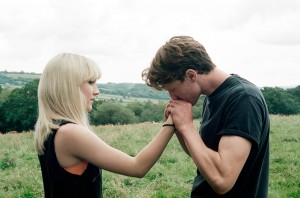film review: how i live now
An adaptation of Meg Rosoff’s 2004 novel of the same name, How I Live Now, follows Elizabeth/Daisy (Saoirse Ronan)—a cinematic ‘angry teen’ caricature—as she is sent to the English countryside to stay with her cousins. There’s the broody and handsome Edmund (George McKay), Isaac (Tom Holland), and Piper (Harley Bird). Elizabeth, who rechristens herself Daisy to dissociate herself from a neglectful father, is initially unhappy at being exiled to England, but slowly warms to life on the farm as she begins to develop romantic feelings for Edmund. When a nuclear bomb is dropped on London, the family is split up—the girls sent to a labour camp, the boys conscripted into the army—and the film focuses on Daisy who, with Piper in tow, must now fight her way back to the farm, to Edmund, and to the possibility of life after war.
How I Live Now is part of a broader cultural obsession with survivalist narratives. These stories realise our deepest fears about excessive consumption, impending environmental catastrophe, or of the human potential for inhumanity. Zombies = the planet eating itself; we’re worried about the environment, or the rapid advance of science. Vampires = a supernatural avatar for the greed of the 1%. The human race has been cinematically eaten alive, invaded by aliens, polluted, abandoned, and neglected into oblivion a thousand times over.
It’s a curious thing that cinemagoers are so keen to see their world destroyed on screen. It’s not clear why—are we looking for advice on how to deal with our impending doom? How I Live Now positions Daisy as a role model. As an apocalyptic how-to guide, she’s not half bad. She is strong, determined; she’s not just a male action hero with boobs, but a fully fleshed out, flawed character, who is allowed to have emotions without being narratively punished for them.
I was exceedingly grateful that How I Live Now did not take the damsel-in-distress route, and have her rescued by Edmund. The filmmakers have Daisy find her motivation to escape the labour camps, and to fight off rapist soldiers in her love for Edmund. Her capacity to love transforms her from a hard-shelled, angry teen into a homemaker, nurse, and mother-figure to Piper.
Daisy tackles her fears and becomes a better person through the catalyst of war. The film interrogates a series of modern, Western anxieties—that we are too stressed, that we are over-medicated, that we are out of touch with the land we live on. Daisy, who arrives swaddled in oversize headphones and rock music, dressed in the standard punk uniform, is gradually softened throughout the film. She begins dressing in cosy, neutral knits; she no longer listens to music but instead tends to the vegetable garden and she learns to reconnect with the world around her.
How I Live Now illustrates the worst parts of our nature: the potential to embrace violence and rape. We see some of the film’s soldiers do this, and derive sadistic pleasure from the game of it. But we also see the weakest elements of humanity: the construction of false hope and clinging to it; or to become (alarmingly quickly!) downtrodden and drone-like.
Were the apocalypse to happen right now, we would most likely find ourselves amongst the film’s extras—the thousands of unnamed, subdued characters, who work in the labour camps and keep their heads down. We would most likely fit into the mass group who obey orders and forget to question whether or not they should.
But I’m sure we’d prefer to think of ourselves as Daisies: fierce, rebellious, strong, righteous, driven, better than we were before. We’d like to imagine that in a crisis we would become our best selves, not our worst.
As we champion Daisy from our popcorn-strewn seats, we endorse some of her more questionable acts because it seems to us, in times like those shown on screen, that survival of the fittest is the only remaining moral choice.


